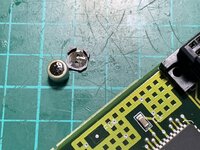bigmessowires
Well-known member
I'm branching off the discussion from a for-sale post about whether original unused motherboards in a vacuum-sealed bag would be less likely to need recapping than used motherboards. And putting the discussion in this forum, since it's the most hardware-oriented.
I don't know exactly what makes electrolytic capacitors leak and fail after a few decades. But in general when you think about computers, cars, bridges, or anything else man-made that breaks down over time, it's due to chemical changes in the materials they're built from. And those changes are usually caused or exacerbated by:
An unused motherboard in a vaccum-sealed bag, and stored in a dark place at room temperature, will be quite well protected from all four of those destroyers. That's not a guarantee the capacitors will still be good after 40 years, since the electrolyte may also react with the seal or other components. I don't think you can stop cap rot forever. But if I were a betting man, I'd bet that sealed NOS motherboards would be in substantially better shape than other identical motherboards the same age. Thoughts?
I don't know exactly what makes electrolytic capacitors leak and fail after a few decades. But in general when you think about computers, cars, bridges, or anything else man-made that breaks down over time, it's due to chemical changes in the materials they're built from. And those changes are usually caused or exacerbated by:
- heat
- oxygen
- UV light exposure
- water (liquid water or just humidity)
An unused motherboard in a vaccum-sealed bag, and stored in a dark place at room temperature, will be quite well protected from all four of those destroyers. That's not a guarantee the capacitors will still be good after 40 years, since the electrolyte may also react with the seal or other components. I don't think you can stop cap rot forever. But if I were a betting man, I'd bet that sealed NOS motherboards would be in substantially better shape than other identical motherboards the same age. Thoughts?




